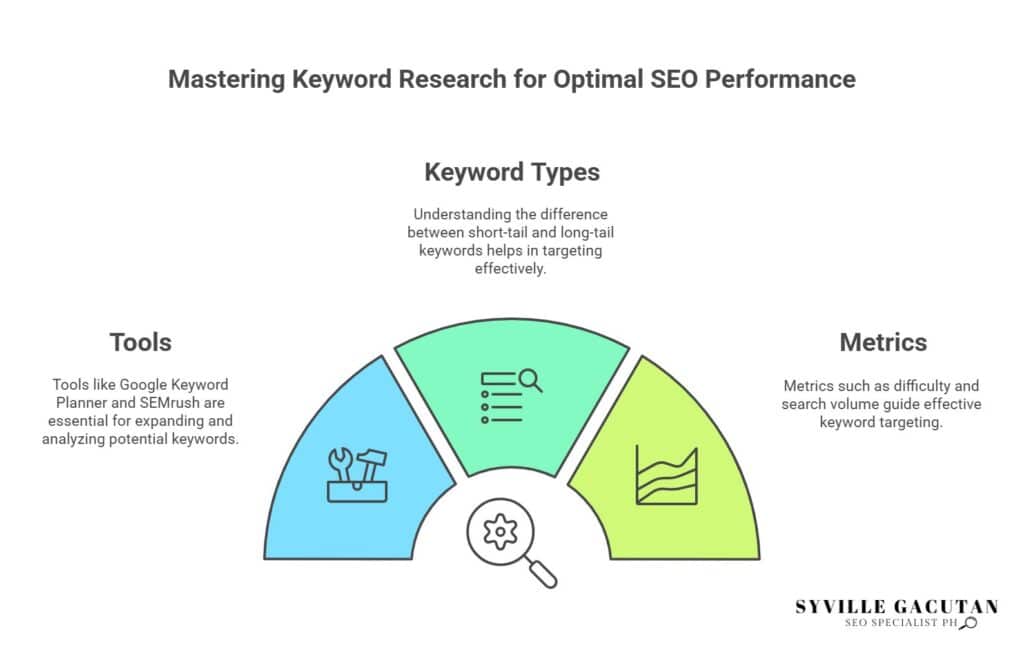
What Is Keyword Research in SEO for Newbies?
Keyword research is a key part of SEO that helps you understand the words and phrases your potential visitors are using when they search online. This process allows websites to draw in the right audience, fine-tune on-page elements like meta tags and headers, and boost overall user engagement. By evaluating search volume, competition, and the intent behind keywords, businesses can prioritize the most effective terms that align with their objectives. Leveraging tools like Google Keyword Planner and SEMrush helps to expand and refine keyword choices. When integrated properly, keywords boost content visibility and overall performance, making it more discoverable and impactful. Grasping the nuances between short and long-tail keywords can significantly impact conversion rates. Learn the details of beginners guide to keyword research SEO.
Key Takeaways
- Keyword research uncovers the terms people commonly use in their searches, helping to optimize content for improved search engine rankings.
- It helps attract relevant traffic, improving user engagement and increasing conversions.
- Tools like Google Keyword Planner and SEMrush expand and analyze potential keywords.
- Short-tail keywords have high search volume but high competition; long-tail keywords are more specific and convert better.
- Keyword metrics like difficulty and search volume guide effective keyword targeting to enhance visibility and competitiveness.

Importance of Keyword Research
Keyword research is vital in SEO, as it can significantly impact the success of your online visibility and help you reach the right audience effectively. Grasping the significance of keyword research is essential for anyone looking to optimize their website and achieve higher search engine rankings.
SEO keyword research involves uncovering and understanding the exact words and phrases that potential customers naturally use when looking for products, services, or information related to your business.By focusing on the right keywords, you can draw in more relevant visitors to your site, enhance user engagement, and ultimately boost conversions, leading to better overall business outcomes.
The importance of keyword research lies in its ability to uncover valuable keyword ideas that align with your target audience’s search intent. This process involves several steps, including brainstorming, using keyword research tools, analyzing competition, and refining your list of keywords. Properly executed, the keyword research process enables you to create content that resonates with your audience and addresses their needs effectively.
Moreover, SEO keyword research helps you stay ahead of the competition by revealing gaps in the market that you can exploit. By understanding what keywords your competitors are targeting, you can identify opportunities to differentiate your content and offer unique value.
Additionally, keyword research is important for optimizing various on-page elements such as meta tags, headers, and content, ensuring that search engines understand the relevance of your pages.
Identifying Target Keywords

Identifying target keywords is the next step after understanding the importance of keyword research. This crucial phase involves pinpointing the specific terms and phrases that potential visitors are likely to use when searching for information related to your business or website.
A well-crafted keyword strategy begins with a thorough keyword search to uncover relevant keywords that align with your content and audience needs.
To identify target keywords effectively, start by brainstorming a list of potential keywords that are directly related to your business, products, or services. Utilize tools like Google Keyword Planner, SEMrush, or Ahrefs to expand this list by discovering additional relevant keywords and assessing their search volume and competition levels.
These tools provide insights into how often certain keywords are searched and how competitive those terms are within your industry.
Next, analyze the intent behind each keyword. Understanding whether users are looking for information, seeking to make a purchase, or comparing options can help you prioritize keywords that align with your objectives.
For example, a keyword strategy focused on attracting potential buyers might prioritize terms indicating commercial intent, such as “buy,” “discount,” or “deal.”
Additionally, consider the relevance and specificity of the keywords. Broad terms might attract a larger audience but could lead to higher bounce rates if the content does not meet user expectations.
Conversely, more specific keywords can draw a targeted audience with a higher likelihood of engagement and conversion.
Short vs Long-Tail Keywords
The balance between short and long-tail keywords is essential in crafting a robust SEO strategy. Grasping the differences between short-tail and long-tail keywords can greatly enhance your SEO strategy, allowing you to effectively target both broad and specific search queries for optimal results.
Short-tail keywords, also known as head terms, are typically one to two words long and have a high keyword search volume. Examples include “shoes” or “digital marketing.” While these keywords can attract a large number of visitors, they are highly competitive and may not always lead to high conversion rates.
On the other hand, long-tail keywords are longer phrases, often three or more words, that are more specific and have lower keyword search volume. Examples include “running shoes for flat feet” or “best digital marketing strategies for small businesses.” Long-tail keywords typically bring in more qualified traffic because users searching with these specific terms are often further along in their decision-making process, ready to make a purchase or take action.
For beginners diving into keyword research, it’s important to understand the benefits and drawbacks of both short-tail and long-tail keywords. This knowledge will help you strike the right balance between driving traffic and targeting users more likely to convert. Short-tail keywords can increase overall visibility and drive significant traffic to your site, but the competition can be fierce.
On the other hand, long-tail keywords might bring in less traffic, but their specificity and lower competition often lead to better conversion rates, making them a powerful tool for reaching more targeted audiences.
Finding Keyword Opportunities

Understanding the balance between short-tail and long-tail keywords lays a solid foundation for identifying potential keyword opportunities. Finding keyword opportunities is a pivotal step in keyword research for SEO. By leveraging a keyword research tool, you can uncover terms that your audience actively searches for, allowing you to optimize your content effectively.
The journey begins with understanding search volume, which indicates the frequency of searches for a particular keyword. High search volume keywords may seem attractive, but they often come with high competition. Conversely, low search volume keywords could present niche opportunities with less competition.
To identify the best keyword opportunities, you should utilize the best keyword research tools available. These tools can provide insights into keywords that have a balance of decent search volume and manageable competition. Some popular keyword research tools include Google Keyword Planner, SEMrush, and Ahrefs.
Here is a table that evokes the emotion of excitement and curiosity as you explore these tools:
| Tool | Feature |
| Google Keyword Planner | Free access, search volume data |
| SEMrush | Competitive analysis, keyword difficulty |
| Ahrefs | Comprehensive backlink analysis |
| Mangools | User-friendly interface, detailed metrics |
When finding keyword opportunities, focus on relevance to your content and the potential for driving traffic. Remember, the right keywords are those that align with your audience’s intent and your SEO goals. By strategically integrating these keywords, you enhance your site’s visibility and improve your chances of attracting engaged visitors.
Using Keyword Data Effectively

Effectively utilizing keyword data involves more than simply identifying high-traffic keywords; it requires a strategic approach to ensure that the keywords are integrated into your content in a meaningful way. The best keyword research not only identifies popular search terms but also analyzes their relevance and competition levels. By doing so, you can craft content that satisfies both search engines and user intent.
First, leveraging keyword research tools can provide invaluable insights. These tools offer data on search volume, competition, and trends, allowing you to make informed decisions. For instance, tools like Google Keyword Planner or SEMrush can help you identify not just high-traffic keywords but also long-tail keywords that are more specific and less competitive. Long-tail keywords may have lower search volumes, but they often attract more qualified traffic, leading to higher conversion rates.
Next, integrating keyword data effectively means using keywords naturally within your content. Overstuffing your text with keywords can lead to penalties from search engines and a negative user experience. Instead, focus on creating high-quality, informative content that naturally incorporates your target keywords. This includes using keywords in titles, headers, meta descriptions, and throughout the body text in a way that enhances readability and context.
Additionally, monitoring and analyzing the performance of your chosen keywords is crucial. Using keyword research tools, track how well your content is ranking and adjust your strategy accordingly. This iterative process ensures that you are always using the best keyword research practices to stay ahead of the competition.
Prioritizing SEO Keywords
Once you have gathered and analyzed your keyword data, the next step involves prioritizing which SEO keywords to focus on. This crucial stage ensures that your SEO efforts are both effective and efficient. By using a keyword research tool, you can pinpoint the best keyword opportunities and create a strategic plan for implementation.
Firstly, consider the search volume and competition level of each keyword. High-volume keywords may seem attractive but also tend to have higher competition. Balancing these factors is essential. Long-tail keywords, which are more specific and often less competitive, can provide targeted traffic and higher conversion rates.
Secondly, assess the relevance of each keyword to your content and business goals. Prioritizing SEO keywords that align closely with your niche ensures that visitors find your content valuable and relevant, improving user engagement and satisfaction.
To aid in prioritizing, consider creating a table to organize your keyword data. Here’s an example:
| Keyword | Search Volume | Competition Level |
| Best keyword | High | High |
| Long-tail keyword | Medium | Low |
| Targeted phrase | Low | Medium |
| Niche keyword | Medium | Low |
| Broad keyword | High | High |
Using this table, you can clearly visualize which keywords offer the best balance of search volume and competition.
Lastly, regularly review and update your keyword prioritization. SEO is an evolving field, and ongoing analysis ensures you stay ahead of trends and maintain optimal performance. By following these keyword research tips, you can effectively prioritize your SEO keywords and drive meaningful traffic to your site.
Keyword Placement Strategies

When it comes to keyword placement strategies, it’s crucial to ensure that your chosen keywords are integrated seamlessly into your content. Proper keyword placement can significantly impact the effectiveness of your SEO strategies, as it helps search engines understand the relevance of your content to the search queries.
Firstly, the title of your article should include your primary keyword. This not only captures the attention of search engines but also appeals to users scanning through search results. Similarly, incorporating keywords in the subheadings helps segment your content, making it easier for both readers and search engines to navigate.
The introduction and conclusion of your content are key opportunities to incorporate keywords. Introducing your primary keyword early on informs search engines that your content is directly relevant to the subject. Additionally, weaving related keywords throughout the body helps create well-rounded, contextually relevant content that improves SEO and user experience.
Conducting keyword research is important to identify the appropriate keywords to use. Tools and techniques for conducting keyword research can provide insights into what your target audience is searching for, allowing you to optimize your content accordingly.
Moreover, keyword placement strategies should extend to meta descriptions and image alt texts. These elements not only enhance accessibility but also contribute to your overall SEO performance.
For instance, a well-crafted meta description with keywords can increase click-through rates, while alt texts ensure that your images are indexed properly by search engines.
Understanding Keyword Metrics

Understanding keyword metrics is a crucial part of keyword research, as it allows you to evaluate the potential value and effectiveness of specific keywords. These metrics offer insights into the competition, search volume, and overall demand, helping you make informed decisions that can greatly enhance your SEO strategy.
One of the primary metrics to consider is keyword difficulty. This metric indicates how challenging it would be to rank for a particular keyword based on the competition. High keyword difficulty means that many established websites are already ranking for that term, making it harder for new content to break through. Conversely, lower difficulty scores suggest less competition, offering better opportunities for new entries to rank.
Another essential metric is the monthly search volume. This reflects the number of times a keyword is searched for within a month. High search volume keywords can drive significant traffic to your site, but they often come with high competition. Balancing keyword difficulty and monthly search volume is crucial for effective keyword research.
To acquire these metrics, a keyword tool is indispensable. Many tools provide detailed data on keyword difficulty and search volume. Some popular options include paid tools like Ahrefs, SEMrush, and Moz.
However, for those starting out, free keyword research tools like Google Keyword Planner and Ubersuggest offer valuable insights without financial commitment.
Final Thoughts
Keyword research is a foundational aspect of SEO that helps businesses optimize their content for better visibility and engagement. By understanding the difference between short-tail and long-tail keywords, analyzing competition, and utilizing keyword research tools, you can effectively target the right audience and improve conversion rates. Always remember to stay strategic with your keyword choices, focusing not only on high-volume terms but also on those that align with user intent and business objectives. By consistently refining your approach based on keyword data, you can keep your content relevant, competitive, and discoverable, ultimately driving success for your website.
If you’re ready to master keyword research and boost your website’s visibility, connect with Syville Gacutan, an experienced SEO Specialist in the Philippines. Syville can help you identify high-performing keywords, optimize your content, and drive meaningful traffic to your site. Don’t miss the opportunity to elevate your SEO strategy—reach out today!